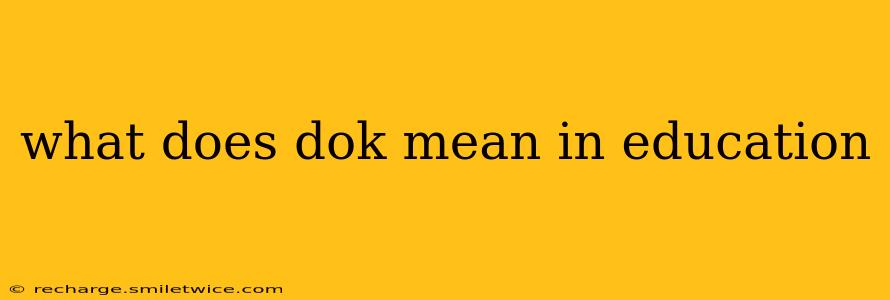What Does DOK Mean in Education?
In the world of education, DOK, or Depth of Knowledge, is a framework used to classify the complexity and cognitive demand of educational tasks, standards, and assessments. It's not a specific curriculum or teaching method, but rather a tool to help educators design effective learning experiences and measure student understanding beyond simple recall. Understanding DOK levels is crucial for creating assessments that accurately reflect the skills students are expected to master.
DOK is organized into four levels, each representing a progressively deeper level of cognitive processing:
1. Recall and Reproduction: This level focuses on retrieving information from memory. It involves basic recall of facts, definitions, terms, and procedures. The tasks at this level require little to no cognitive processing beyond remembering.
- Examples: Listing states and capitals, identifying vocabulary terms, reciting multiplication facts, defining a historical event.
2. Skills & Concepts: This level involves applying learned information to solve problems or answer questions. It goes beyond simple recall and requires students to use their knowledge in a more practical way.
- Examples: Summarizing a text, classifying objects, interpreting graphs, performing basic calculations, applying a formula.
3. Strategic Thinking & Reasoning: This level requires complex reasoning, planning, and problem-solving. Students need to analyze information, make inferences, and justify their conclusions.
- Examples: Comparing and contrasting different perspectives, designing experiments, solving multi-step problems, creating arguments, analyzing a literary work.
4. Extended Thinking & Reasoning: This level involves high-level cognitive processes, often requiring in-depth analysis, synthesis, and evaluation. It frequently involves long-term projects, investigations, or creating original work.
- Examples: Designing a research project and conducting original research, creating a comprehensive presentation on a complex topic, designing a solution to a real-world problem, conducting independent scientific research.
What are the benefits of using DOK in education?
The DOK framework offers several key benefits for educators and students:
- Improved Assessment Design: DOK helps educators create assessments that accurately measure student understanding at different levels of complexity. This ensures that assessments are aligned with learning objectives and provide a more comprehensive picture of student learning.
- Enhanced Instruction: By understanding the DOK level of their lessons, teachers can design more effective instructional activities that challenge students appropriately. This helps to avoid oversimplifying or overcomplicating assignments.
- Better Student Learning: When students are challenged with tasks that align with their current level of understanding, and are progressively pushed to higher DOK levels, their learning is more engaging and effective.
- Clearer Communication: DOK provides a common language for teachers, administrators, and curriculum developers to discuss the cognitive demands of learning tasks and assessments.
How is DOK different from Bloom's Taxonomy?
While both DOK and Bloom's Taxonomy are frameworks for classifying cognitive skills, there are some key differences. Bloom's Taxonomy focuses on the types of cognitive processes (remembering, understanding, applying, analyzing, evaluating, creating), while DOK focuses on the depth of cognitive processing required to complete a task. DOK is more closely tied to assessment design and the complexity of tasks, whereas Bloom's Taxonomy is more broadly applicable to learning objectives and curriculum development.
How can I use DOK to improve my teaching?
Using DOK in your teaching involves:
- Analyzing learning objectives: Determine the DOK level of each learning objective to ensure that your lessons and assessments are aligned.
- Designing appropriate tasks: Create learning activities and assessments that challenge students at different DOK levels.
- Differentiating instruction: Provide differentiated instruction to meet the needs of all students.
- Providing feedback: Give students feedback that focuses on the depth of their understanding, not just whether they got the answer right.
By understanding and applying the DOK framework, educators can create more effective learning experiences that promote deep understanding and critical thinking skills in their students. It's a powerful tool for aligning curriculum, instruction, and assessment for improved student achievement.
